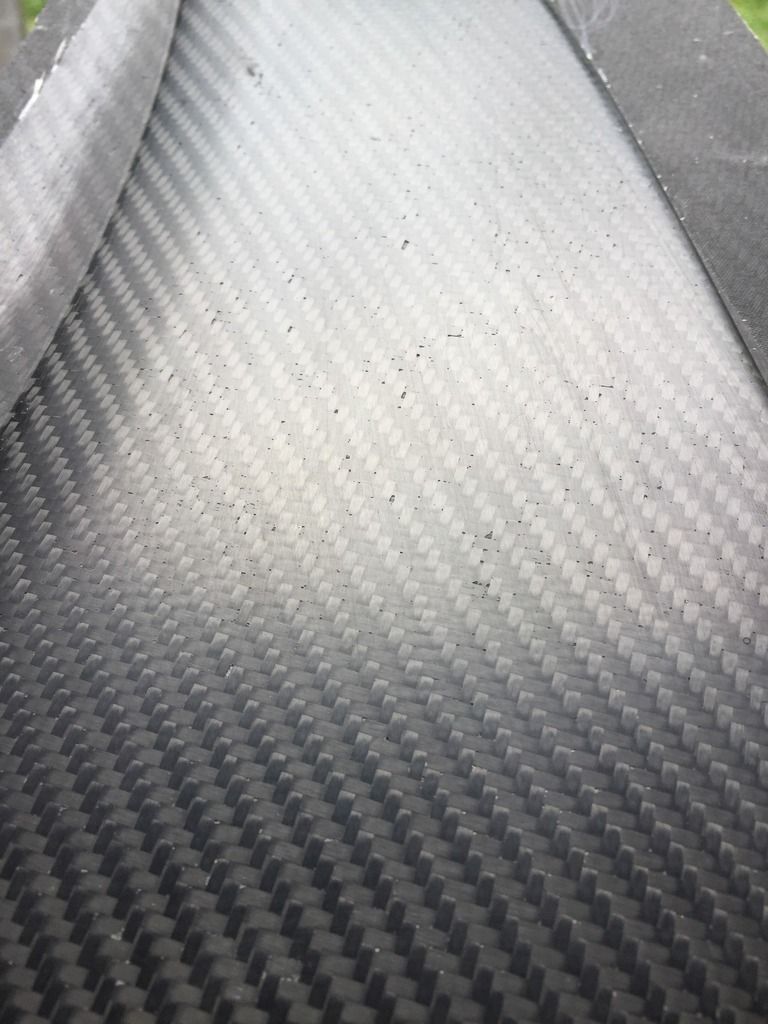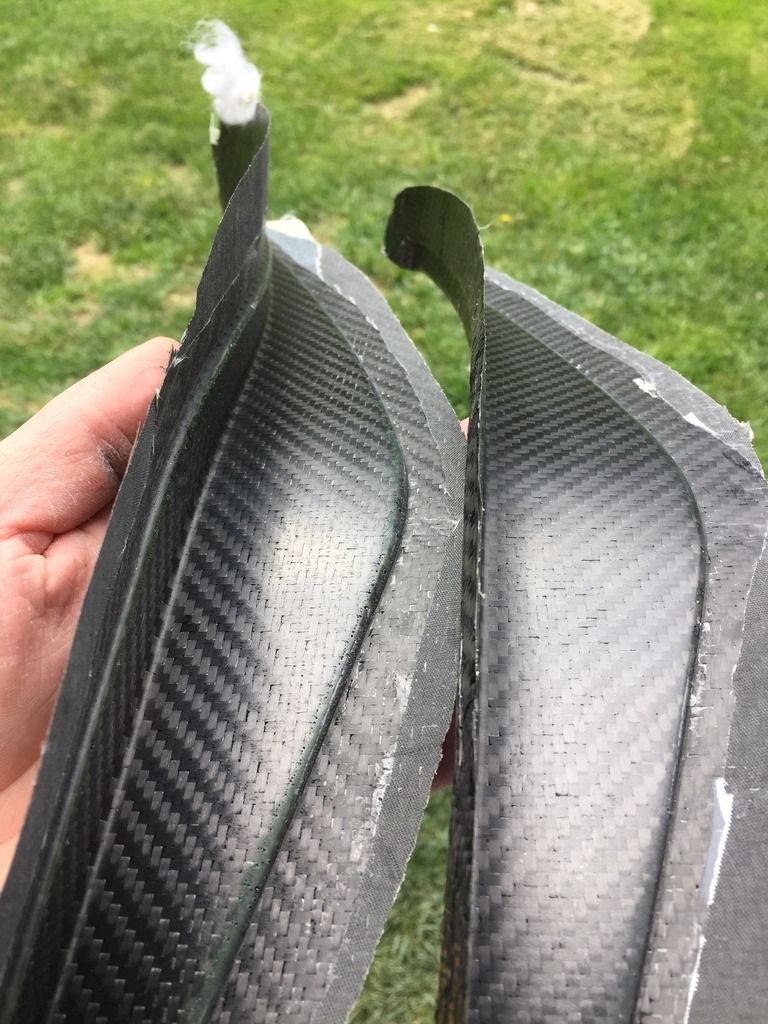It is the DF212… its the best material I have ever used…
Cheers mate, think I need to give it another go!
Sent from my A0001 using Tapatalk
have you tried using teflon tape for your mold surface? Although this can be a expensive solution, it has worked wonders in eliminated surface defects.
If you are getting good surfaces with aluminum but not on gelcoated tools, you probably have vacuum leaks in the gelcoated tools. You cannot get good results with leaky tools.

I can not find enough information about this problem : I have matt surface in all areas where i have to use lot of fixation glue.
MTI hose,no dry spots etc,but those marks…I washed this little area to check if this is 100% the glue influence.
you may need to consider edge damming. you might be drawing out too much resin and/or not enough air.
The prepreg needs to go through a few phases where very important and distinct things need to happen.
1)debulk to remove bulk air and to compact the laminate.
2)temp rise to allow softening of the resin and allow air to escape along the weave of the fabric>for which edge breathing is important (edge damming may also be necessary) whether some tows of glass or breather overlying. This step also at the same time allows the escaping air spaces to be taken up by the flow out of the resin. a certain dwell period may be required at this temp so that enough air/flow out occurs.
3)ramp to cure. all the above have occurred and now it’s time to gel/cure the resin.
in your case either the tool/laminate surface may not be get enough time and/or adequate pathways for the air to escape before curing occurs.
Is it possible that the tool gets more heat on this side the whole time than the rest of the part?
Is it possible that the gel coat is incompatable and off gassing into the laminate?
MTI hose and spray adhesive… You sure you’re in the right thread?
Sorry,you’re right. This is another subject.
I’m having the same issue, Carbon prepreg epoxy mold with a nice glossy surface. No matter what I try when clearing over (Duratec Sunshield) I get like pinholes/fisheye, sand, clear, sand, clear over and over till smooth
I’m still in search of a clear surface coat.
Trying this next.
Our Wonder-Fil is THE SOLUTION to those time consuming, annoying pinholes.x It is a wipe on/wait 15 minutes/wipe off the excess process.x Wonder-Fil shows up in as off-white specks everywhere there are pinholes, and then disappears when the next layer is sprayed on – whether primer, color or clear.
x
This makes it perfect for fiberglass and carbon fiber parts!x Even carbon fiber parts where the weave needs to show through in the clear smooth finish…Wonder-Fil disappears into the clear.x It also works equally well on wooden and fabric surfaces.
Pinholes aren’t a problem with Duratec, it’s as simple as spraying your first wet coat and use a brush to push it into the pinholes, then spraying another coats as per normal. Duratec self-levels so well that 90% of the time it will finish perfectly off the gun and not need any work. The other 10% of the time is normally if it is a bit warm or the Duratec was catalysed a bit too high and it doesn’t have time to flow out before it starts to set up. In which case 20 minutes of sanding will flat the surface.
I’ve heard of Wonder-fil before, but from what I’ve read it doesn’t really work as well as its claimed. I’d get some and give it a go, but honestly I just find the Duratec so easy to use I don’t want to bother with yet another product.
I’ve tryed the Duratec clear top coat, turns yellow can’t handle the 275 degrees.
…
This is straight out of the mould. No pinholes here. Its also not an alloy mould this is just a high temp polyester based tooling from Nord Composites.

Nice. What carbon fixation glue do you prefer ?
That will be a pre-preg tank I’m sure.
It is a pre-preg tank yes… If Spaggiari is asking about bonding the sections together though. I use a Phenol Novolac base resin with several additives and thickeners to use it both as an ethanol sealer and an adhesive when I bond the base into the tank shell. As I make up the adhesive myself I am keeping the exact ingredients to myself… 
I know this is not 100% answer to your pinholes, that being said always wipe your mold surface with a tack cloth to remove fine dust particles. Also you probably need a more resin rich prepreg for your first layer in the mold.
This does make sense… BUT there are also some materials that do have a higher resin content that will still have pinholes. You may find that one material that does not work perfectly can be made to work perfectly if you change the cure schedule a little too… Either several steps with 1,2 or 3 increases in temperature with a dwell time between each step. A lower/higher final cure temperature or a change of ramp rate too.
It can be a bit of work getting a material to work perfectly but once you have it cracked use a decent ramp and dwell controller so you automate the curing process.
The material I use is 41% resin weight. I have tried 48% and it was worse as it is all down to the chemistry of the resins used and how it works in the oven. I am sure the 48% material could have been made to work but I got the other material to work first and have stuck with it…
Does anyone have experience with APCM DA4090 MX? It is a 250F cure single side coated prepreg. Here is my experience:
This is my best result - a 10 ply laminate cured with a one hour debulk at 100F, then a 2.5 degree/minute ramp to 250 with a 1 hour hold. Presumably the additional voids that appear on the surface in the thinner parts below are trapped somewhere in the middle of the part:

The two parts below are 4 ply laminates and were cured as follows: on the left - a 1 hour debulk at 100, followed by several 2.5 degree per hour ramps and 1 hour holds at 150, 200, and 250, with a 2.5 degree per hour ramp down. On the right - a 12 hour room temperature debulk with a 1 degree per hour ramp to 250 and 1 hour hold. Slow ramp down as before, of course.

All parts are laid up with the tacky side down and a layer of peel ply between the first layer and the tool surface. I have not tried a lower temperature cure yet. I have a call scheduled with APCM on Monday to talk things over, but also an inquiry submitted to Cytec for more info on the VTF261 - I have heard great things about it. Most of the advice I’ve heard about APCM has been from guys on their shop floor laying up flat panels for testing purposes. I would love to use a material that has some additional pedigree.
I will update as I gather additional information.
Thanks and Happy Easter.
Nick
